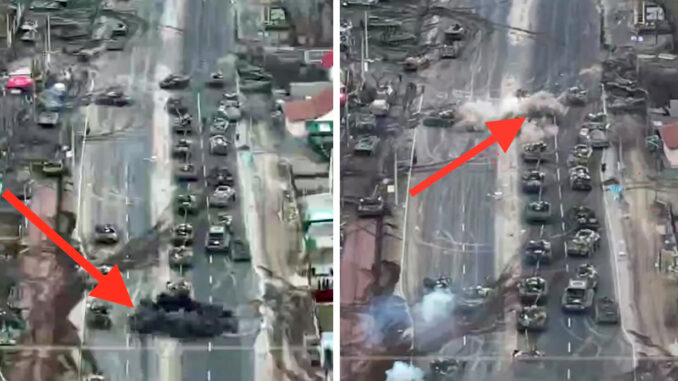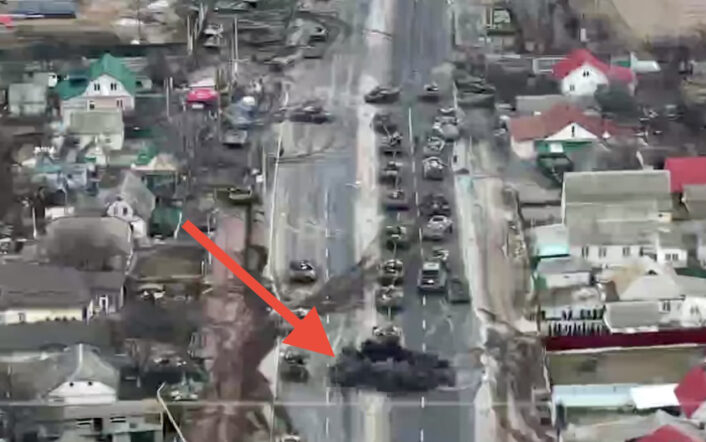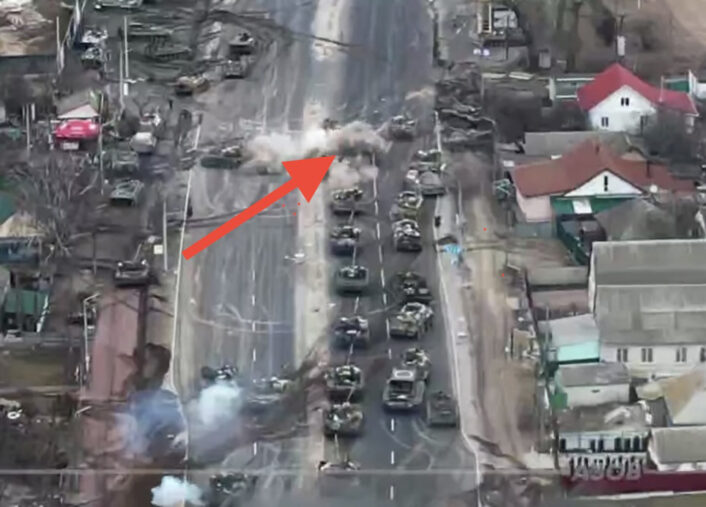Into the Kill Zone: Ukrainian Drone Video Shows Textbook Anti-Armor Ambush

Deadly, Portable Anti-Armor Weapons Tip the Scale in Favor of Highly Mobile Infantry Units.
It looks like an instructional video from the U.S. Army Infantry School at Ft. Benning, Georgia. Or perhaps a cautionary video for tank crews at the Armor School there.
As video continues to surface from the conflict in Ukraine, these images of a column of Russian tanks being ambushed in a classic anti-armor missile engagement will likely be watched and re-watched by tank crews around the world. This video is a worst-case scenario for tank crews.
Any time an armored column is forced to move through an urban environment surrounded by buildings and constrained to driving on a road, the vehicles in the armored column loose one of their biggest advantages; the ability to maneuver.
Heavy tanks in a closely spaced column with buildings on each side have only two directions to move, forward or rearward. Opposing force anti-tank units can easily cover both escape venues when initiating an ambush with lightweight, portable anti-tank missiles. This is the tipping point on the fulcrum of asymmetrical warfare for small units that are well-drilled and well equipped with modern anti-tank weapons. A small number of skilled and daring infantrymen can take on a large column of heavy tanks and win.
Ukrainian forces are using a broad assortment of portable anti-tank weapons ranging from the old and relatively small 66mm M72 Light Anti-Tank Weapon (LAW) to the lethal and highly advanced FGM-148 Javelin, and nearly everything in between. The Ukrainians are throwing the anti-armor kitchen sink at the advancing Russians, and according to most western media accounts and the maps of Russian progress in Ukraine, these anti-tank weapons and the tactics used to employ them are proving to be at least somewhat effective, perhaps highly effective, in slowing the Russian advance.
This video surfaced on Mar. 9, 2022, on the ukraine_defence social network channels. It shows what is likely 10 Russian heavy tanks and additional, lighter armored vehicles entering a Ukrainian village. The scenario is bad for the Russians.
The vehicle column is constrained to one road, hemmed-in by buildings on both sides with limited or no escape routes. Obstacles placed in the single road slow the advance of the vehicles through the urban area. The column slows, the vehicles bunch up. The ambush is initiated.
The first target is the vehicle at the front of the column, the “point” position. Once disabled by an anti-tank missile, the following vehicles have only two choices; attack directly into the ambush, a common counter-ambush infantry doctrine, or, reverse out of the kill zone, a much less viable and potentially deadly alternative since this escape route is almost always covered by another anti-tank missile team. In this case, attacking directly into the direction of fire proves to be impractical for the Russian column because of the buildings on either side of the road. The armored column is trapped in the kill zone.

Anti-tank crews maintain the initiative by firing another missile at the vehicle at the rear of the column, effectively trapping every vehicle between the front and the back of the column in the kill zone. From there, all the Russians can do is fight back against an unseen enemy and likely “die in place”, or dismount and run for it, almost always another lethal alternative.

The Ukrainians have not only been effective in employing small unit tactics, as illustrated in this video, against Russian forces, they’ve also been successful in employing another lethal and modern weapon on the battlefield in Ukraine; social media. While there are videos from state-sponsored media of Russian successes in Ukraine appearing on YouTube and in other social media, the traffic numbers on that media has been miniscule compared to the number of views, shares and impressions of Ukrainian shared social media of “kill TV” videos and imagery like this one. If the social media battlefield weighs on the outcome of this conflict, at least in the west, Ukraine is leveraging both battlefield tactics and social media tactics to craft what appears to be the impression of effective resistance.
Intelligence estimates suggest that Russia is using T-90s, T-72s and the possibly even their new, highly advanced T-14 Armata tank in Ukraine.
By the way, the video highlights the importance of drones in this conflict: we are not talking about the Turkish-made Bayraktar TB2 drones that have become so popular on social media but also much smaller and COTS (Commercial Off The Shelf) ones particularly useful for spotting enemy activities from distance and film hi-rez footage that can be used to boast the successes of the Ukrainian forces against the Russian invaders.



Ingen kommentarer:
Legg inn en kommentar
Merk: Bare medlemmer av denne bloggen kan legge inn en kommentar.